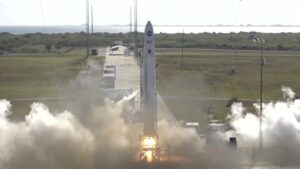Op-ed | Russian Invasion of Ukraine Reinforces the Urgency of Fixing U.S. Satellite Vulnerability by 2027
Tuesday, 08 March 2022 15:15
Russia's invasion of Ukraine could portend dark things to come for Taiwan. But while it's widely understood that a clear and credible capability to thwart Chinese invasion is critical to maintaining peace in the Taiwan Straits, less understood is the role U.S.
North Korea claims new test of 'reconnaissance satellite' component
Tuesday, 08 March 2022 11:28 North Korea carried out "another important test" towards the development of a reconnaissance satellite, state media said Sunday, but analysts warned it was a thinly-veiled ballistic missile launch, just days before South Korea elects a new president.
From hypersonic to medium-range ballistic missiles, Pyongyang test-fired a string of banned weaponry in January and last week launched what it
North Korea carried out "another important test" towards the development of a reconnaissance satellite, state media said Sunday, but analysts warned it was a thinly-veiled ballistic missile launch, just days before South Korea elects a new president.
From hypersonic to medium-range ballistic missiles, Pyongyang test-fired a string of banned weaponry in January and last week launched what it California fire led to spike in bacteria, cloudiness in coastal waters
Tuesday, 08 March 2022 11:28 The November 2018 Woolsey Fire in Southern California's Los Angeles and Ventura counties left more than a nearly 100,000-acre burn scar behind: It also left the adjacent coastal waters with unusually high levels of fecal bacteria and sediment that remained for months.
For a new study, published in Nature Scientific Reports, scientists combined satellite imagery, precipitation data, and wat
The November 2018 Woolsey Fire in Southern California's Los Angeles and Ventura counties left more than a nearly 100,000-acre burn scar behind: It also left the adjacent coastal waters with unusually high levels of fecal bacteria and sediment that remained for months.
For a new study, published in Nature Scientific Reports, scientists combined satellite imagery, precipitation data, and wat NASA Studies 'New' 50-Year-Old Lunar Sample to Prep for Return to Moon
Tuesday, 08 March 2022 11:28 People say good things come to those who wait. NASA thinks 50 years is the right amount of time as it begins tapping into one of the last unopened, Apollo-era lunar samples to learn more about the Moon and prepare for a return to its surface.
The sample is being opened at NASA's Johnson Space Center in Houston by the Astromaterials Research and Exploration Science Division (ARES), which sa
People say good things come to those who wait. NASA thinks 50 years is the right amount of time as it begins tapping into one of the last unopened, Apollo-era lunar samples to learn more about the Moon and prepare for a return to its surface.
The sample is being opened at NASA's Johnson Space Center in Houston by the Astromaterials Research and Exploration Science Division (ARES), which sa Astra blames launch failure on wiring error and software flaw
Tuesday, 08 March 2022 11:26
Astra Space said March 7 it identified two problems that led to the failure of a launch last month as the company gears up for a new launch that may be imminent.
The post Astra blames launch failure on wiring error and software flaw appeared first on SpaceNews.
SpaceX worked for weeks to begin Starlink service in Ukraine
Tuesday, 08 March 2022 09:35
SpaceX’s president says the company had been working for weeks to secure approval for Starlink services in Ukraine before a government minister tweeted a request to Elon Musk.
The post SpaceX worked for weeks to begin Starlink service in Ukraine appeared first on SpaceNews.
WashU scientists help recover gases from Moon rock time capsule
Tuesday, 08 March 2022 04:50 St. Louis MO (SPX) Mar 08, 2022
Scientists from Washington University in St. Louis are helping to recover gases from a container of lunar soil that astronauts collected and sealed under vacuum on the surface of the Moon in 1972. The effort is part of NASA's Apollo Next Generation Sample Analysis (ANGSA) initiative.
Apollo 17 astronauts Harrison Schmitt and Eugene Cernan collected the samp
St. Louis MO (SPX) Mar 08, 2022
Scientists from Washington University in St. Louis are helping to recover gases from a container of lunar soil that astronauts collected and sealed under vacuum on the surface of the Moon in 1972. The effort is part of NASA's Apollo Next Generation Sample Analysis (ANGSA) initiative.
Apollo 17 astronauts Harrison Schmitt and Eugene Cernan collected the samp NASA expands research into mining lunar ice, minerals to sustain humans on the moon
Tuesday, 08 March 2022 04:50 NASA's desire to mine ice and minerals on the moon is driving new research on Earth into how astronauts could use moon materials to make machine parts, pave roads and construct living quarters. Scientists have studied lunar rocks brought back from Apollo missions, and NASA has confirmed the existence of water ice in craters on the moon's South Pole. University scholars and engineers at NASA are
NASA's desire to mine ice and minerals on the moon is driving new research on Earth into how astronauts could use moon materials to make machine parts, pave roads and construct living quarters. Scientists have studied lunar rocks brought back from Apollo missions, and NASA has confirmed the existence of water ice in craters on the moon's South Pole. University scholars and engineers at NASA are Probe to look for water on moon
Tuesday, 08 March 2022 04:50 China plans to send its Chang'e 7 robotic probe to search for water and other resources at the moon's south pole, according to a leading space scientist.
"The Chang'e 7 mission is set to find traces of ice at the south pole, investigate the environment and weather there, and survey its landforms," said Wu Weiren, chief designer of China's lunar exploration program and an academician of the
China plans to send its Chang'e 7 robotic probe to search for water and other resources at the moon's south pole, according to a leading space scientist.
"The Chang'e 7 mission is set to find traces of ice at the south pole, investigate the environment and weather there, and survey its landforms," said Wu Weiren, chief designer of China's lunar exploration program and an academician of the Challenges await sample-return expedition to Mars
Tuesday, 08 March 2022 04:50 Chinese scientists and engineers will need to solve a host of technological challenges to accomplish an ambitious sample-return mission to Mars, said Wu Weiren, a key figure in the country's deep-space exploration program and also a top political adviser.
A senior scientist with the China National Space Administration and academician of the Chinese Academy of Engineering, Wu said the missi
Chinese scientists and engineers will need to solve a host of technological challenges to accomplish an ambitious sample-return mission to Mars, said Wu Weiren, a key figure in the country's deep-space exploration program and also a top political adviser.
A senior scientist with the China National Space Administration and academician of the Chinese Academy of Engineering, Wu said the missi Event horizons are tunable factories of quantum entanglement
Tuesday, 08 March 2022 04:50 LSU physicists have leveraged quantum information theory techniques to reveal a mechanism for amplifying, or "stimulating," the production of entanglement in the Hawking effect in a controlled manner. Furthermore, these scientists propose a protocol for testing this idea in the laboratory using artificially produced event horizons. These results have been recently published in Physical Review Le
LSU physicists have leveraged quantum information theory techniques to reveal a mechanism for amplifying, or "stimulating," the production of entanglement in the Hawking effect in a controlled manner. Furthermore, these scientists propose a protocol for testing this idea in the laboratory using artificially produced event horizons. These results have been recently published in Physical Review Le Detecting ultralight dark matter using quantum technology
Tuesday, 08 March 2022 04:50 A new study led by Tel Aviv University researchers demonstrates unprecedented sensitivity to an exciting dark matter candidate. As part of the new NASDUCK ("Noble and Alkali Spin Detectors for Ultralight Coherent dark-matter") collaboration, the researchers developed unique innovative quantum technology that enables receiving more accurate information on invisible theoretical particles "suspecte
A new study led by Tel Aviv University researchers demonstrates unprecedented sensitivity to an exciting dark matter candidate. As part of the new NASDUCK ("Noble and Alkali Spin Detectors for Ultralight Coherent dark-matter") collaboration, the researchers developed unique innovative quantum technology that enables receiving more accurate information on invisible theoretical particles "suspecte NeoPhotonics offers ultra-narrow linewidth laser for LEO satellites
Tuesday, 08 March 2022 04:50 NeoPhotonics Corporation (NYSE: NPTN), a leading developer of silicon photonics and advanced hybrid photonic integrated circuit-based lasers, modules and subsystems for bandwidth-intensive, high-speed communications networks, has announced its new Radiation Tolerant version of its industry leading Nano ultra-pure light tunable laser which has been designed for use in low earth orbit satellite co
NeoPhotonics Corporation (NYSE: NPTN), a leading developer of silicon photonics and advanced hybrid photonic integrated circuit-based lasers, modules and subsystems for bandwidth-intensive, high-speed communications networks, has announced its new Radiation Tolerant version of its industry leading Nano ultra-pure light tunable laser which has been designed for use in low earth orbit satellite co China's space station to host 6 astronauts by end of 2022
Tuesday, 08 March 2022 04:50 China's space station is expected to host six astronauts from two spaceships by the end of 2022, according to the chief designer of the country's manned space program.
The Shenzhou-13 crew has been in orbit for 140 days. They are in good health, and have so far completed all planned or added tasks as needed. They are expected to return to Earth in mid-April, Zhou Jianping said.
This
China's space station is expected to host six astronauts from two spaceships by the end of 2022, according to the chief designer of the country's manned space program.
The Shenzhou-13 crew has been in orbit for 140 days. They are in good health, and have so far completed all planned or added tasks as needed. They are expected to return to Earth in mid-April, Zhou Jianping said.
This China launches seven new satellites
Tuesday, 08 March 2022 04:50 China has successfully sent seven satellites into space from the Xichang Satellite Launch Center in southwest China's Sichuan Province Saturday.
Six satellites produced by Beijing-based GalaxySpace and a commercial remote sensing satellite were launched by a Long March-2C carrier rocket at 2:01 p.m. (Beijing Time) and have entered their planned orbit.
The satellites will verify the n
China has successfully sent seven satellites into space from the Xichang Satellite Launch Center in southwest China's Sichuan Province Saturday.
Six satellites produced by Beijing-based GalaxySpace and a commercial remote sensing satellite were launched by a Long March-2C carrier rocket at 2:01 p.m. (Beijing Time) and have entered their planned orbit.
The satellites will verify the n 